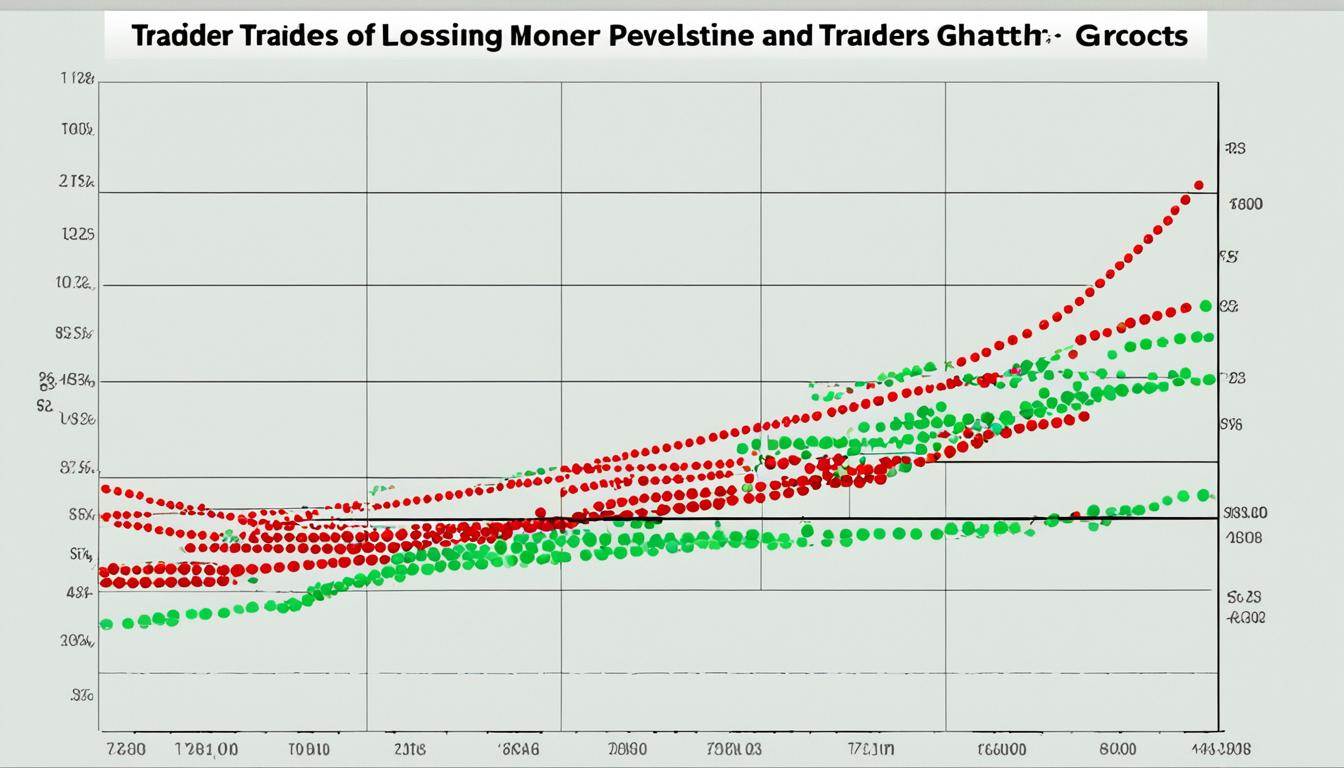Many aspiring traders face the harsh truth that a large number lose money. Emotional decisions, lacking skills, and trusting luck over research are big reasons. It’s key to know how many traders lose money before diving into the financial markets.
Looking at traders’ money loss rates shows trading success isn’t easy or quick. It’s tough and demands a lot of professionalism and skill growth.
For those wanting to do better, tracking and analyzing trades is crucial. Tools like the Edgewonk trading journal offer deep insights into how well traders perform. They help spot common mistakes that lead to financial losses.
Key Takeaways
- A high percentage of traders lose money due to emotional and impulsive decisions.
- Lack of proper skills and relying on luck are big reasons for trading failures.
- Using research-based strategies is key to trading success.
- Knowing about traders’ money loss rates helps understand trading’s challenges.
- Being professional and always improving your skills is vital for trading success.
Understanding the Sobering Statistics Behind Traders Losing Money
Trading can be tough. Many start with big dreams but face harsh realities. Studies from trading platforms and regulators show how many lose money.
How Many Traders Lose Money?
The numbers on trading losses are scary. A big part of traders end up losing. About 70% to 80% of retail traders lose money, stats show. This shows how important it is to know the market and use smart trading strategies.
Traders Losing Money Statistics
Looking at past data, some trends stand out. The number of traders losing money stays steady over time. Groups like the CFTC and FINRA report many retail traders losing money. Surveys show new traders are often the ones losing the most.
Highest Percentage of Traders Losing Money
Forex trading has the highest loss rates, with up to 90% losing money. This is due to high leverage in forex, which can make losses bigger. Knowing this is key for anyone thinking of trading, as it stresses the need for knowledge, experience, and careful risk management.
Reasons Why Traders Lose Money
Exploring why traders lose money can help us understand trading better. It covers common mistakes and psychological hurdles. Knowing these is key for traders wanting to succeed in the markets.
Common Pitfalls in Trading
Traders often lose money due to bad strategies. This includes taking on too much risk, not setting stop-loss orders, and following the market too closely. Experts say not having a solid trading plan and poor risk management lead to big losses.
Psychological Factors
Emotions play a big part in trading losses. Fear and greed can cause rash decisions that go against a trader’s plan. Studies show that staying disciplined and controlling emotions is vital to avoid big mistakes.
Lack of Knowledge and Experience
Not knowing enough about trading is another big issue. Without understanding the market and ongoing learning, traders make wrong assumptions and mistakes. Research shows that beginners often face big losses because of the steep learning curve. This underlines the need for good education and practical experience.
| Reason | Impact |
|---|---|
| Over-leveraging | Can lead to significant losses even with small market moves. |
| Emotional Decision-making | Impulsive trades based on fear or greed often result in losses. |
| Lack of Technical Knowledge | Misunderstanding market signals can lead to poor trading decisions. |
What Percent of Traders Lose Money?
Knowing how many traders lose money is key for everyone in the market. Studies show that a big part of traders end up losing instead of winning. It’s vital to look at these numbers for a clear view of the market risks.
Studies say that between 70% to 90% of traders lose money on average. This trend is seen in many markets and trading places.
Looking back over the last ten years, the data also shows a high loss rate. Even with some ups and downs, the main number stays high.
Let’s compare trader statistics across different areas:
| Region | Average Percentage of Traders Losing Money |
|---|---|
| North America | 75% |
| Europe | 80% |
| Asia | 83% |
These numbers underline the need for a careful look at market risks before trading. Knowing these stats helps both new and seasoned traders plan better and cut down on losses.
Insights into Trader Profit and Loss Ratios
In the world of trading, knowing about profit and loss ratios is key to doing well over time. These ratios show how well a trader is doing and if their strategies work. By looking at these ratios, traders can spot trends and make better choices to increase their earnings.
Profit vs. Loss Ratios Explained
Profit and loss ratios show the balance between wins and losses over a set time. A high ratio means a trader makes more money than they lose. A low ratio means they need to work on their trading methods. Things that affect these ratios include market conditions, how well they manage risks, and how well they stick to their plans.
Real-Life Examples of Successful vs. Unsuccessful Traders
Looking at real-life trading examples shows what makes some traders successful. Successful traders use careful risk management, deep market analysis, and flexible strategies. On the other hand, struggling traders often lack discipline, have weak plans, and can’t adjust to market changes.
| Trader | Profit Ratio | Loss Ratio | Key Strategies |
|---|---|---|---|
| Paul Tudor Jones | 4.5 | 1.0 | Risk management, Diversification |
| Bill Ackman | 3.8 | 1.2 | Thorough research, Adaptive strategies |
| Unsuccessful Trader | 0.8 | 3.2 | Lack of planning, Poor discipline |
Understanding and improving profit and loss ratios is crucial for trading success. By learning from both the successes and failures of others, people can better handle the market’s challenges. Regularly analyzing and adjusting trading strategies is key to keeping a good profit ratio and cutting losses.
Conclusion
Looking back, analyzing trading outcomes shows a tough road to success. Many traders struggle to make it consistently. We’ve seen the tough stats and common mistakes, and the balance between wins and losses. It’s clear that lasting success in trading is hard to find.
These insights tell us how crucial a smart, disciplined approach is in trading. Overconfidence and taking too many risks are big hurdles. Studies confirm that most day traders end up losing money.
In conclusion, learning from trading losses is key for those serious about trading. Adopting a long-term, varied strategy can lead to better financial growth. So, managing risks wisely and keeping up with learning are essential. They help turn the tough trading outcomes into stories of resilience and success.
FAQ
How Many Traders Lose Money?
Many traders lose money. The Financial Conduct Authority (FCA) and trading platforms say about 70-80% of retail investors lose when trading CFDs, Forex, and other derivatives.
What are the Common Reasons Traders Lose Money?
Traders lose for many reasons. These include not knowing enough, making decisions based on feelings, and not managing risks well. Not understanding the market and using too much leverage can also lead to big losses.
What Percent of Traders Lose Money?
About 70-80% of traders lose money on average. This can change based on the type of trading, market conditions, and the time frame. Platforms like MetaTrader and eToro show these numbers.
What are the Psychological Factors Affecting Traders?
Fear, greed, and overconfidence affect trading decisions a lot. Studies in behavioral finance show how emotions can make traders stray from their plans. This often leads to big financial losses.
What are the Highest Percentage Figures for Traders Losing Money?
Some markets like binary options and highly leveraged derivatives have loss rates over 85%. Regulatory bodies warn retail investors about these markets.
What are the Traders Losing Money Statistics?
Statistics on traders losing money vary but show most lose capital. The U.S. Commodity Futures Trading Commission (CFTC) reports that many new traders lose money in their first year.
What are Trader Profit and Loss Ratios?
Profit and loss ratios show how much traders earn and lose. Successful traders usually make more than they lose, with a ratio above 1:1. They follow good trading strategies and manage risks well.
What are Some Real-Life Examples of Successful vs. Unsuccessful Traders?
Case studies show both successful and unsuccessful traders. Successful ones use disciplined strategies, manage risks well, and keep learning. Unsuccessful ones often lack planning, struggle with emotions, and don’t understand the market well.






